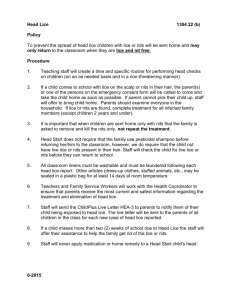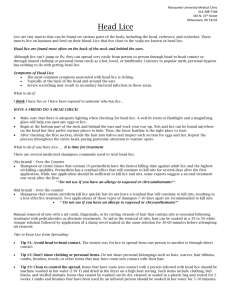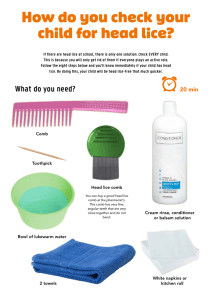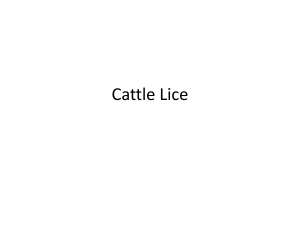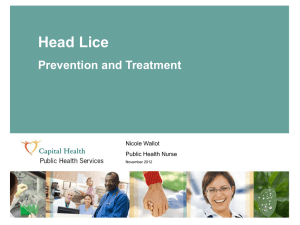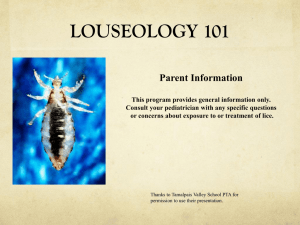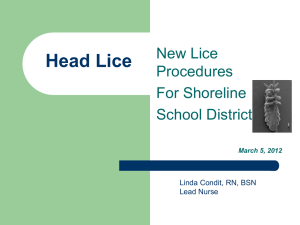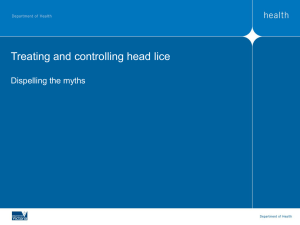overview of headlice for parents
advertisement
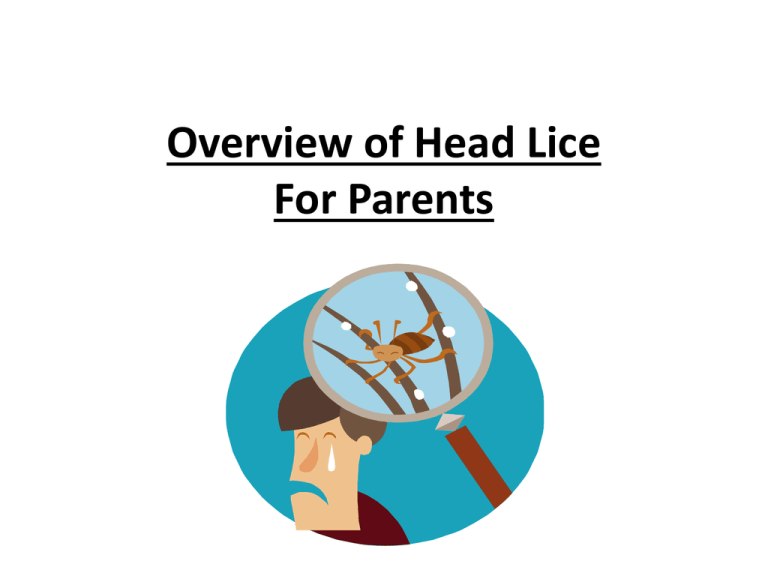
Overview of Head Lice For Parents What are Head Lice? • Small, wingless, crawling insects about 1/8 of an inch long (about the size of a sesame seed) • They do not jump, hop or fly • They are bloodsucking, parasites that live and feed on the human head Nits • The female louse can lay 5-6 eggs per day about 50-150 in her lifetime • Eggs (nits) hatch in 5-10 days and reach maturity in 8-10 days • Nits are about 1/32 of an inch, oval-shaped, grayish-white and are glued to the hair shaft Lice Facts • • • • An adult louse has a life span of about 30 days More than 12 million people contract head lice each year Head lice are most common in children age 3 years to 12 years old Outbreaks can show up at anytime but are most prevalent when kids are heading back to school and after vacations (August-October, and again in January) Symptoms of Head Lice • Persistent itching of the scalp • Tickling feeling of something moving in the hair • Scratch marks (sometimes get infected) or what appears to be a rash around the hairline/neck • Tiny white-yellowish or grayish oval nits attached to the hair shafts most often found around the ears and the nape of neck How is Head Lice Spread? • Head lice are transmitted most frequently from the head of an infested person to another individual through direct contact. • Head lice can also be transmitted by sharing personal items such as combs, brushes, towels, bedding, pillows, sleeping bags, clothing, hats, ribbons, hair decorations, scarves, sweaters, coats, stuffed animals etc. • Upholstered furniture, the backs of chairs and car seats are also possible but unlikely sources. Treatments for Head Lice • Over-the-Counter (OTC) products: (NIX, RID) • Prescription products: (Ovide, Lindane) • Alternative Therapies: natural and herbal These products have NOT been proven effective and are not regulated by the FDA • Nit picking (hair combing) with a fine tooth comb to remove nits from the hair. Combing takes time and patience. Alone, it is NOT considered an effective treatment for head lice. Combing does not kill lice. How To Get Rid Of Head Lice 1. Choose a proven method of treatment (pediculicide). Consult your doctor or pharmacist for treatments that work best. 2. Follow directions exactly as written on the manufacturer’s label (including retreatment). 3. After appropriate treatment, REMOVE ALL NITS with a lice comb. This is a time consuming process and hair should be parted into sections. 4. Check for nits daily for the next 10-14 days and more if needed. 5. Check everyone in the house for signs of lice. Treat others if necessary at this time. Do not treat prophylactically Clean Personal Items and Surroundings • Machine wash all washable and possibly infested items (clothes, hats, scarves, blankets, sheets and towels) in hot water. Dry them in hot dryer. • Put non-washable items (furry toys or pillows) in hot dryer for 20 minutes or dry clean them. • Seal items that cannot be washed or dried in a plastic bag for 10 days. • Soak combs, brushes and hair accessories for 10 minutes in hot soapy water or put in the dishwasher using sterilize cycle. • Thoroughly vacuum rug, upholstered furniture, mattresses ,cars and car seats. Throw out vacuum cleaner bags immediately after use. Head Lice in the School • If you notice your child has head lice please notify the school nurse. You should also notify your child’s friends or those she/he has been in close contact with. • If the school nurse finds head lice/nits on your child, you will be called to pick-up for treatment. • Please let the nurse know what method of treatment you are using, and the date you started. • The school nurse will need to check your child before restarting school South Kingstown School District Policy on Head Lice Policy 5141.4 Any student who is found to have lice or nits in his/her hair will be excluded from school until after treatment with the proper type shampoo and all lice/eggs/nits have been removed from the hair. The student will be examined by the school nurse and declared free of lice/eggs/nits before being allowed to return to classes. • South Kingstown School District has a policy which is stricter than the Rhode Island Department of Health with the goal of preventing transmissions at school. Myths About Head Lice • Dirty kids spread lice. Head lice have no preference for dirty hair or clean hair. • Pets spread lice. False, your pets will not give you lice nor will they get head lice. • You can get diseases or die from head lice. False, head lice do not carry or pass deadly diseases they just make you itch. • Insecticide shampoos can be toxic. Pyrethrine is a natural extract from the chrysanthemum plant and permethrin is the synthetic form. If different treatments are prescribed they are considered safe when used properly. • If I sit next to someone with head lice I will get it. False, head lice do not fly, jump or hop into someone else’s hair. For More Information • Websites: • • • • • www.health.state.ri.us/disease/communicable/pediculosis.php www.cdc.gov/lice/head www.headlicetodeadlice.com http://www.youtube.com/watch?v=UCoZP5Aso5U Part 1 http://www.youtube.com/watch?v=QGvGY72zAqI&list=UL Part 2

